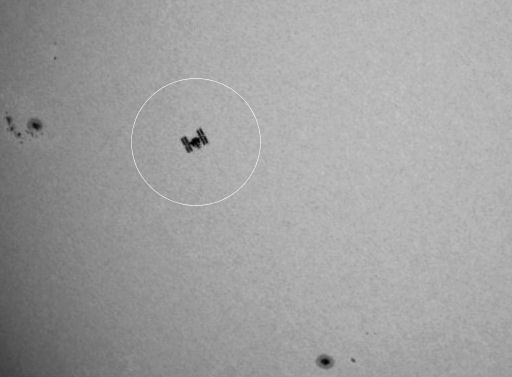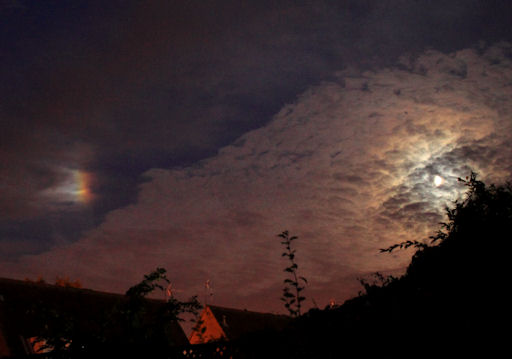They came from outer space--and you can have one! Genuine meteorites are now on sale in the Space Weather Store. | | |
QUIET SUN: Except for some minor rumblings on the sun's northeastern limb, solar activity is very low. The sun's X-ray output has nearly flatlined and NOAA forcasters put the odds of a major flare today at less than 10%.
FAST-MOVING SUNSPOT: Today in the blue skies above Scarborough Marsh, Maine, a dark-winged shape flitted across the face of the sun. It was the International Space Station:

"The ISS cut across the sun, transiting the entire solar disk in only 7/10th of a second," says amateur astronomer John Stetson who photographed the passage with split-second timing. "In today's transit the ISS appeared to be 54 arc seconds in angular diameter." In other words, it subtended an angle about the same as the planet Jupiter. Because the ISS is so large, it is possible to see the details of its structure through backyard telescopes. Here's a telescope that works both during the day and at night.
Stetson notes that is this a good week for ISS flybys of the United States. When it is not transiting the sun, the space station typically appears in the evening sky shining as brightly as Venus or Jupiter. A transit of the entire sky takes about five minutes, so finding and tracking the behemoth spacecraft is easy if you know when to look. ISS flyby alerts: text, phone (Note to subscribers: Select the "backyard astronomy" option.)
WATCH OUT FOR MOONDOGS: The moon is waxing full this week, which means it's a great time to look out for moondogs. They appear 23 degrees from the moon, splashes of light shining with the colors of a rainbow, but they are not rainbows. Barry Starling of Histon UK photgraphed this specimen on August 25th:

Unlike rainbows, which are caused by raindrops, moondogs are caused by ice crystals. Even during the summer, high clouds are cold enough for water in them to crystallize. When moonlight shines through the icy clouds, voila!--a moondog. High-altitude ice crystals can also make moon haloes and pillars, so watch out for them, too.
Realtime Space Weather Photo Gallery
Realtime Aurora Photo Gallery
Realtime Noctilucent Cloud Photo Gallery
[previous years: 2003, 2004, 2005, 2006, 2007, 2008, 2009, 2011]
Potentially Hazardous Asteroids (
PHAs) are space rocks larger than approximately 100m that can come closer to Earth than 0.05 AU. None of the known PHAs is on a collision course with our planet, although astronomers are finding
new ones all the time.
On August 27, 2012 there were potentially hazardous asteroids.
Notes: LD means "Lunar Distance." 1 LD = 384,401 km, the distance between Earth and the Moon. 1 LD also equals 0.00256 AU. MAG is the visual magnitude of the asteroid on the date of closest approach. | | The official U.S. government space weather bureau |
| | The first place to look for information about sundogs, pillars, rainbows and related phenomena. |
| | Researchers call it a "Hubble for the sun." SDO is the most advanced solar observatory ever. |
| | 3D views of the sun from NASA's Solar and Terrestrial Relations Observatory |
| | Realtime and archival images of the Sun from SOHO. |
| | from the NOAA Space Environment Center |
| | the underlying science of space weather |

